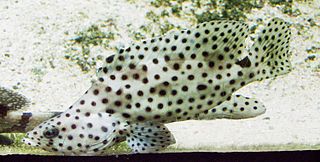
The Serranidae are a large family of fishes belonging to the order Perciformes. The family contains about 450 species in 65 genera, including the sea basses and the groupers. Although many species are small, in some cases less than 10 cm (3.9 in), the giant grouper is one of the largest bony fishes in the world, growing to 2.7 m in length and 400 kg (880 lb) in weight. Representatives of this group live in tropical and subtropical seas worldwide.
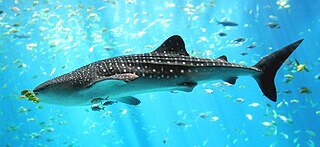
Carpet sharks are sharks classified in the order Orectolobiformes. Sometimes the common name "carpet shark" is used interchangeably with "wobbegong", which is the common name of sharks in the family Orectolobidae. Carpet sharks have five gill slits, two spineless dorsal fins, and a small mouth that does not extend past the eyes. Many species have barbels.
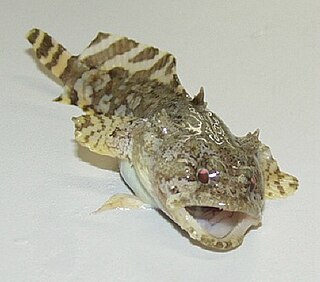
Batrachoididae is the only family in the ray-finned fish order Batrachoidiformes. Members of this family are usually called toadfish, or "frogfish": both the English common name and scientific name refer to their toad-like appearance.

A midshipman fish is any species of toadfish belonging to the genus Porichthys. Midshipman fish are distinguished by their photophores and four lateral lines. Typical midshipman fishes, such as the plainfin midshipman, are nocturnal and bury themselves in sand or mud in the intertidal zone during the day. At night they float just above the seabed. Some species have venomous dorsal spines and are capable of inflicting serious injuries if handled.

Anthias are members of the family Serranidae and make up the subfamily Anthiinae. Anthias make up a sizeable portion of the population of pink, orange, and yellow reef fishes seen swarming in most coral reef photography and film. The name Anthiidae is preoccupied by a subfamily of ground beetles in the family Carabidae created by Bonelli in 1813 and this grouping should be called the Anthiadinae. However, both the 5th Edition of Fishes of the World and Fishbase give the Serranid subfamily as "Anthiinae".

Apogon is a large genus of fish in the family Apogonidae, the cardinalfishes. They are among the most common fish on coral reefs. Over 200 species have been classified in genus Apogon as members of several subgenera. Some of these subgenera, such as Ostorhinchus, have been elevated to genus status, leaving just over 50 species in the genus.
The whitelined toadfish is a species of fish in the family Batrachoididae. It is endemic to Belize. The specific name honours David W. Greenfield and Teresa Arambula Greenfield, who when they collected type specimen thought that it might belong to an undescribed species and so sent it to Bruce Baden Collette to be described.
The reticulated toadfish is a species of fish in the family Batrachoididae endemic to Belize.

Torquigener is a genus of pufferfishes native to the Indian and Pacific oceans. Their name refers to their ability to build circular structures on sandy sea bottom.

Tetraroginae is a subfamily of marine ray-finned fishes, commonly known as waspfishes or sailback scorpionfishes, belonging to the family Scorpaenidae, the scorpionfishes and their relatives. These fishes are native to the Indian Ocean and the West Pacific. As their name suggests, waspfishes are often venomous; having poison glands on their spines. They are bottom-dwelling fish, living at depths to 300 metres (980 ft). These creatures usually live in hiding places on the sea bottom.
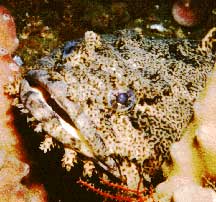
Toadfish is the common name for a variety of species from several different families of fish, usually because of their toad-like appearance. "Dogfish" is a name for certain species along the gulf coast.

The banded toadfish is a species of toadfish found along the Pacific coast of South America where it is found in Chile, Ecuador and Peru. This species grows to a length of 28 centimetres (11 in) TL. It is the only member of the monotypic genus Aphos. Unlike the other genus, Porichthys in this subfamily the banded toadfish lacks photophores.
Austrobatrachus is a genus of toadfishes found in the Atlantic and Indian Oceans off the coast of South Africa.
Barchatus is a genus of toadfish native to the western Indian Ocean, Somalia and the Red Sea.

Colletteichthys is a genus of toadfishes found in the western Indian Ocean. The generic name is a compound of the surname Collette, in honour of the American ichthyologist Bruce Baden Collette to recognise his contribution to the study of toadfish, and the Greek ichthys meaning "fish".

Batrachoidinae is a subfamily of toadfish in the family Batrachoididae. It contains 25 species in the following 6 genera:
Porichthyinae is a subfamily of toadfish in the family Batrachoididae. They are found in the eastern Pacific Ocean and western Atlantic from Canada to Argentina. The species of this subfamily have no venom glands or subopercular spines, they have canine like teeth and two solid spines in the dorsal fin.
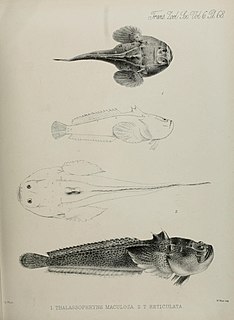
Thalassophryninae is a subfamily of toadfish in the family Batrachoididae. The species in the subfamily are characterised by the possession of two dorsal fin spines, a lack of subopercular spines, with the dorsal and opercular spines being hollow and have venom glands at their base. They do not have canine teeth.

Batrachomoeus trispinosus, the three-spined frogfish or Broadbent's frogfish, is a species of Indo-Pacific toadfish, from the largely Old World subfamily, Halophryninae, of the family Batrachoididae. It is the type species of the genus Batrachomoeus. It is said to be the only fish known to cry like a baby and produce complex non-linear calls. Others fish can only make simple linear sounds but human babies and other mammals use non-linear sounds in their calls, in which other animals associate such non-linear sounds with a sense of emotional urgency.

Thalassophryne maculosa, the Cano toadfish, is a species of toadfish which is common along the Caribbean coasts of South America from Colombia to Trinidad and Venezuela. It occurs on the sandy bottoms of reef flats, lagoons, and seaward edges of reefs where it sits partially buried in the substrate. It is a venomous species with the venom being delivered through spines and wounds from the spines have been known to cause severe symptoms of pain and illness that may persist for up to a week. A study of the holotype of Batrachus uranoscopus, said to be a freshwater toadfish from Madagascar, in the Muséum national d’Histoire Naturelle in Paris found that it was most probably a misslabelled specimen of Thalassophryne maculosa and that subsequent records of Batrachus uranoscopus were attributable to Allenbatrachus meridionalis, a species found in Madagascar. T. maculosa is the type species of the genus Thalassophryne, the generic name translates from Greek as "sea toad" while the specific name is Latin for "spotted".















